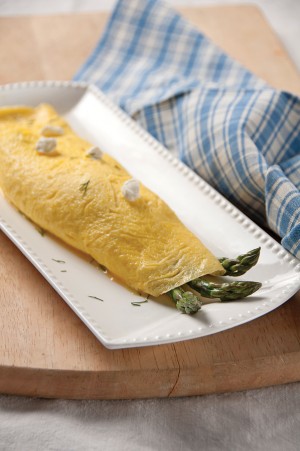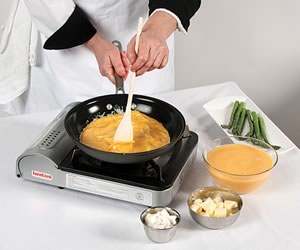French omelettes
Some form of the omelette has been around practically since humans first learned to crack an egg.
An omelette is elegant in its simplicity: eggs, butter and seasoning. Well prepared, this uncomplicated dish is a miracle of taste and texture, but cooked badly, it can be a struggle to eat.
My first attempt at omelette-making was during the first year of my apprenticeship at the Windsor Arms Hotel in Toronto. Most of the hotel’s chefs were European in 1979 and their omelette of choice was the classic French. Preparing this Cadillac of omelettes requires a bit of joie de vivre and a copious amount of pan shaking and technique. To a young apprentice, omelette-making belonged in that same flashy, magical world as igniting liquor in a hot pan: It was fun and very impressive-looking.
One day, during a lull in the breakfast service, I finally had my chance. As I looked at the rather uninspiring ladleful of beaten eggs that I held in my hand, I fretted with second thoughts. Was I ready for such a difficult task? The English chef, who stood by my side, nudged me in his no-nonsense way. So, with no time to waste, I emptied the eggs into the hot pan.
Co-ordination – in a pat-your-head, rub-your-stomach sort of way – is the key to creating this dish. While pushing and pulling the pan back and forth on the gas burner, I simultaneously swirled the eggs quickly with a wooden spoon. When the eggs were cooked to the chef’s liking, I reversed my grip on the pan handle and, tilting the pan up, tapped its edge lightly on the stove to loosen the egg. With one quick movement, I flipped the finished omelette over and on to the plate. Voilà! In one minute, I had created my first masterpiece.
After waiting proudly for a few moments to allow those around me to catch their breath and exclaim hearty congratulations, I glanced around and realized that there would be no such acclamation. To cover my disappointment, I placed the pan on the burner for omelette number two. After all, practice makes perfect.
Some form of the omelette has been around practically since humans first learned to crack an egg. A version of the omelette can be found in the earliest known book of recipes, Apicius, dating back to second-century Rome. One dish in this ancient book is called Ova spongia ex lacte. The short list of ingredients included eggs, milk and oil which were beaten together, baked in a broad shallow dish known as a patina, then drizzled with honey. Even by modern epicurean standards, this recipe still passes muster and is very similar to the Italian frittata or the Spanish tortilla.
Before attempting to make a perfect omelette, you will need the right equipment. A non-stick omelette pan is essential. The pan must be durable, yet light enough to manoeuvre easily, and it must maintain an even, consistent heat. The sides should slope slightly outward to facilitate the removal of the finished omelette. In the past few years, the once-popular Teflon non-stick pan has received negative publicity due to chemicals used in its production. As well, Teflon’s non-stick surface will only last two to four years at most. In response, cookware companies have developed a plethora of non-stick pans, making it a challenge to assess their safety and durability.
The two omelette pans best suited to French-style omelette-making are ceramic-coated or carbon-steel. Ceramic-coated, hard-anodized aluminium pans are preferred by cooks who don’t want to season a pan themselves.
The hard-anodized process produces a metal twice as hard and durable as steel, yet is comfortably lightweight and maintains an even temperature. Some brands feature a stay-cool handle and all have a scratch-resistant surface that is non-toxic and chemical-free. Cleanup is quick and easy with warm water and soap. Expect to pay $50 to $70 for this type of pan. I use a Cuisinart Green Gourmet 10-inch skillet and have been very pleased with its performance.
My second choice, the carbon-steel or black Lyon pan, is not well-known outside professional kitchens; however, it is making a well-deserved comeback among a new generation of chefs. This lightweight pan is made of hammered steel and must be seasoned before first use. Once seasoned, it produces a reliable non-stick surface with a quick, even heat. The pan can be found online only and instructions on how to season it are included with the purchase. I purchased my 9½-inch pan from abestkitchen.com for a very reasonable $20.








